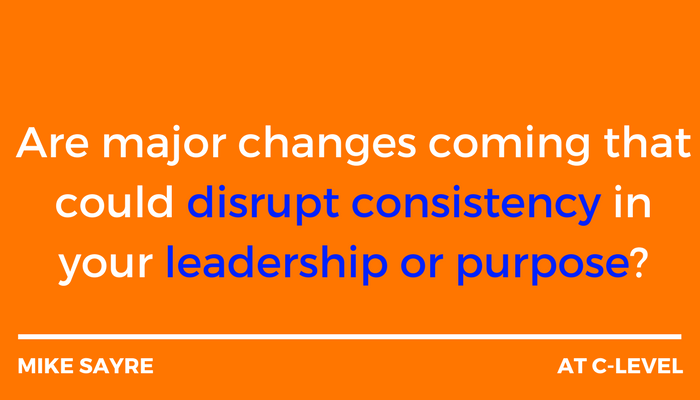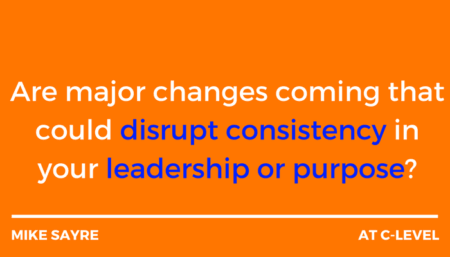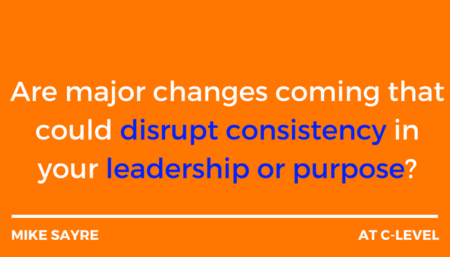At C-Level #17: Embedding Transformations
 Mike Sayre is a highly experienced and successful software, e-commerce, and manufacturing services CEO, COO, CFO, and Board Director. He is also the president & COO of Metcalf & Associates, a trusted partner inspiring and enabling perpetual innovation, evolution, and growth in leaders and their businesses. Mike was featured in Maureen Metcalf’s May 2017 Innovative Leaders Driving Thriving Organizations interview on VoiceAmerica entitled “7 Characteristics of Leadership 2020 In Practice: A CEO Story.”
Mike Sayre is a highly experienced and successful software, e-commerce, and manufacturing services CEO, COO, CFO, and Board Director. He is also the president & COO of Metcalf & Associates, a trusted partner inspiring and enabling perpetual innovation, evolution, and growth in leaders and their businesses. Mike was featured in Maureen Metcalf’s May 2017 Innovative Leaders Driving Thriving Organizations interview on VoiceAmerica entitled “7 Characteristics of Leadership 2020 In Practice: A CEO Story.”

In At C-Level #10-18, I write about three of the most successful transformations I’ve had the opportunity to lead in my career so far, following a seven-step transformation model like the Metcalf & Associates Innovative Leadership Transformation Model below.

Embed Transformation
Merriam-Webster defines embed, “to make something an integral part of,” and integral as “essential to completeness.”
Based on these definitions – and my experience – for a transformation to become embedded in the organization, its purpose and initiatives must be essential to achieving the organization’s mission and vision, and how it operates every day.
Embedding transformations requires a well-defined purpose and initiatives that clearly
- support the organization’s mission and vision,
- have the total commitment and support of the organization’s leadership,
- improve the lives of those responsible for making and sustaining the changes (Why else would they support it?), and
- include implementing enough structure or process to make the initiatives easily sustainable long-term, with feedback loops and action cycles built in to keep them relevant to the business of the organization as it changes over time.
Also, important to embedding transformations is maintaining consistency in leadership and purpose. I would not recommend investment in transformational change if the window of consistency in leadership and/or purpose is not expected to be long enough for your organization to see the positive return on its transformation investments.
Are major changes in your organization coming that could disrupt consistency in the leadership and purpose of your organization?
Let’s see how we did in the three transformations I outlined in At C-Level #10:
- Large Manufacturing Company. In our transformation to upgrade basic financial reporting controllers into true financial business partners in a large and growing company (our vision), we had two major initiatives:
- implementing new automated accounting and financial reporting systems; and
- creating a “controller-in-training” program to prepare up-and-coming and new controllers for the growth of the business and being true financial business partners.
By all measures, both initiatives independently met the requirements for success and were successful in this company, embedding many great changes in its financial organization for several years.
The system was essential and integral to the controllers’ function and gave them more tools and time for the reporting, analysis and business partnering for which we had hoped.
And, over about five years, the controller-in-training program had 40-plus participants, with over 25 percent of them landing internal controllerships – several being chosen for financial leadership in new facilities each representing investments of $100M to $200M.
These two transformation initiatives completed, changes were embedded in the organization, and the returns on those investments were realized.
At the overall transformation level, we lacked deep definition of our purpose and vision and how that supported the overall vision of the organization. We had not taken the time to dive into the details of what the controllers being business partners would really look like with some measurement of on-going success and sustainability, and we did not have any initiatives specifically for that. That lack of definition and clarity around the vision resulted in the same effect as having our purpose change.
So, while I’d say we made great progress toward the vision and embedded change through our initiatives, we fell just short in achieving our vision and embedding the overall transformation in the organization. Over time, changes in leadership and purpose came and more transformation in different directions followed.
If you are planning a transformation within your organization, is its purpose and vision well defined, including how it directly supports the purpose and vision of the overall organization?
Can you complete the transformation and realize its return on investment before significant changes in purpose or leadership start a new transformation?
- Mid-Size Electronics Manufacturing Services Company. In our transformation “to be the best in the world at what we do,” with our mission to improve the lives all our five stakeholder groups, we had three major initiatives:
- implementing Lean Manufacturing,
- putting repair operations in Europe and Asia, and
- developing and implementing a strategy to better leverage our engineering and manufacturing capabilities, and earn higher margin work.
The company very successfully implemented Lean Manufacturing, driving major change and improvement throughout the business, and becoming a new a way of life, the very definition of “embedded.”
A repair operation was acquired and expanded in Europe and a new operation set up in Asia with a trusted joint venture partner, resulting in robust growth in the high-end electronics repair business.
The new strategy to better leverage our capabilities and increase our margins was in the process of being implemented.
Then a major economic downturn hit that resulted in our losing the funding to complete the third leg of our transformation. We were forced to downsize the company in the middle of implementing our higher-value strategy. We had not implemented that part of our strategy quickly enough. Our purpose changed from transformation – to survival.
However, our completion of the lean operational improvements, international expansion, and downsizing carried the day for the company, quickly returning it to profitability and ultimately resulting in a successful sale to a much larger global company that was able to put it back on a growth path again.
I left the company during this time, so leadership changed as did the purpose. Remember, when leadership changes, there is a new transformation that takes place, whether it is stated explicitly or not – and it did for this organization as well.
Have you ever tried to implement major changes in your organization, only to have a new leader come in and change the direction and/or goals of your organization requiring a dismantling or major change in the work you were in the middle of or had just completed?
For much more on how this transformation unfolded for the company and me, please see At C-Level #1-8, about being a first-time CEO.
- Global Internet Payments Company. In our transformation journey to turn around the culture, improve the operational and financial performance of the company, and increase the company’s value, we had three major initiatives:
- a company culture change driven by a stated mission and operating guidelines, and a change in leadership mindset, communications, and actions,
- the implementation of Agile software development in our company, which requires the involvement of all major functional areas of the company, and
- new strategy development and implementation in marketing and sales.
By all measures, the initiatives were successful, as were we, in achieving our mission and vision of increasing the value of the company for the ownership.
Then, majority ownership of the company was sold at a markedly increased valuation over pre-transformation and new leaders were brought in to take the company to the next level. As in the mid-sized electronics manufacturing company transformation story, the ensuing purpose and leadership changes began yet another totally new transformation.
Key takeaways from these transformations
In all three of the above organizations, much was embedded and achieved in these organizations, including how these organizations were prepared for and adapted to major change. However, the overall visions of these transformations, for the most part, were never completely realized, due to changes in leadership and/or purpose over time, and for a variety of reasons.
In fact, the rate of change in our world today is, and for the foreseeable future will be, exponentially increasing! So, it is even more likely that the time frames for large transformations will get shorter and shorter as we move forward. This makes the organization’s purpose, the leader, and that leader’s purpose in life ever more important in driving focused organizational change and transformation every day.
That increasing rate of change also makes the ability of your organization to adapt ongoing with continuous processes to evaluate and respond to near-constant changes in its environment an absolute necessity to transform, adapt, survive and thrive in the future!
Today, 5S/Lean/Six Sigma and other continuous improvement processes are used to continuously improve products, services and processes, while Agile methodologies are used to run software development that continuously evaluates changing needs to develop and maintain more relevant software products.
These are all transformative changes that become embedded in the organization. Just remember that they are all means to an end – that of carrying out your mission every day and achieving your vision.
In addition, our individual and collective knowledge sets are continuously updated and expanded every day through online content, customized automated news feeds, the use of search tools, webinars, social media, et. al.
But what are people doing, and what specifically are you doing, to continuously update their/your leadership skills today, when the environment in which we are trying to lead is constantly changing, and the people we are attempting to lead are as well? See “At C-Level #9: Evolving Leadership for an Evolving World.”
In “At C-Level #18: Three Successful Transformations – Common Threads,” we’ll look at the three transformations we’ve discussed in At C-Level #10-17 and the key takeaways that you may need to think about in your own organization’s transformative journey.
Thanks for following us! For more information or help, please visit us at www.Metcalf-Associates.com.





